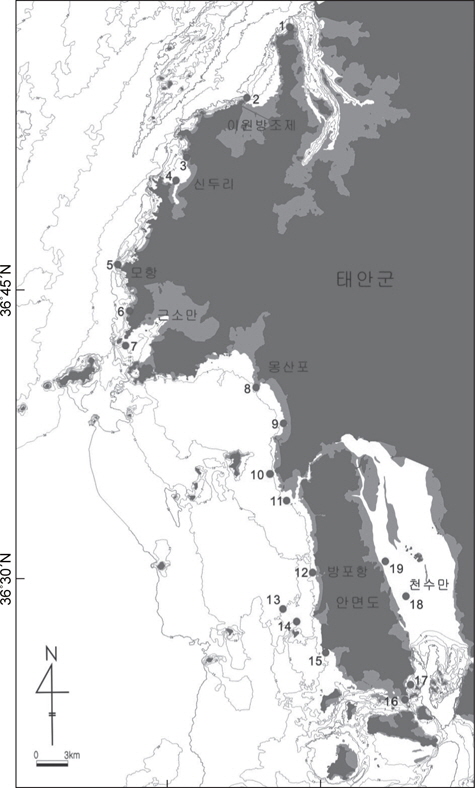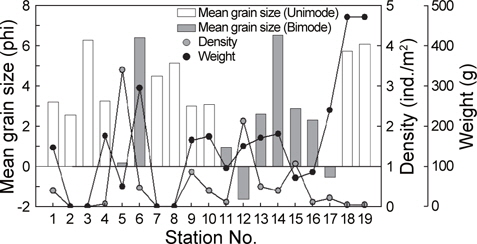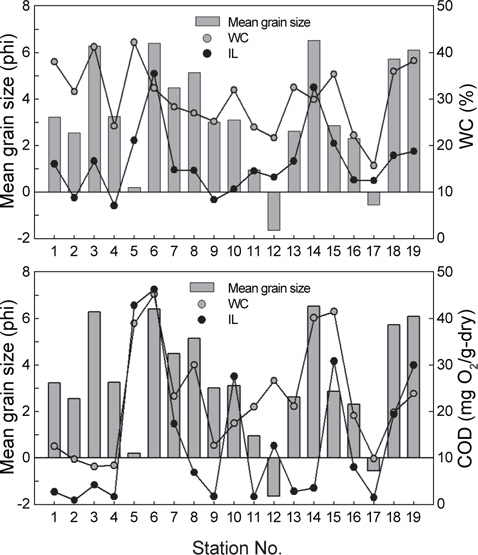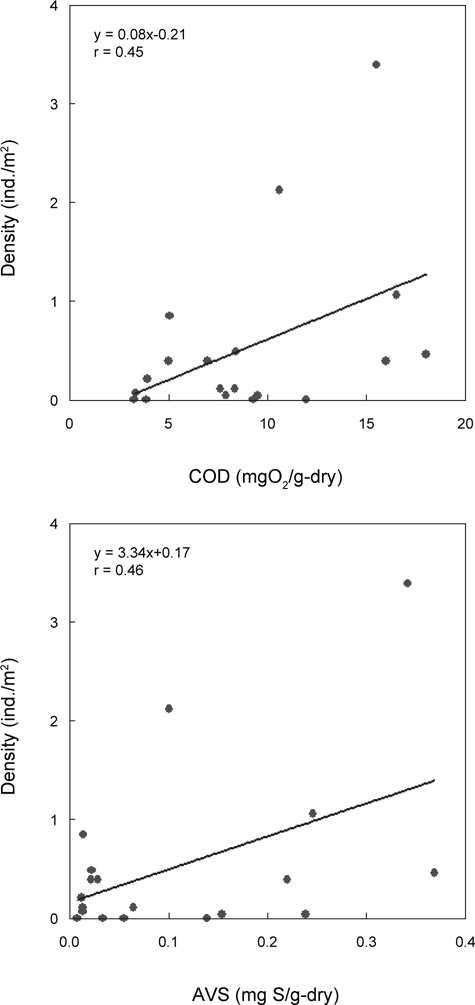



We analyzed surface sediments to explain the substrate characteristics of sea cucumber
우리나라의 해삼 생산량은 1990년에 2,491톤을 기록한 이래로 지속적으로 감소하다가 인공종묘 생산에 의한 소규모의 씨뿌림 양식이 도입된 이후 2010년에 2,687톤으로 빠르게 회복되고 있지만, 아직까지는 수출수요에 비해 생산량이 크게 부족한 실정이다. 씨뿌림 양식은 삼면이 바다이고 광활한 갯벌이 발달한 우리나라의 천혜의 지형적 조건에서 최적의 해삼 양식방법으로 화석연료를 사용하지 않은 자연 의존형 양식 방법으로 녹색성장 산업으로서의 가치 또한 매우 크다. 그러나 지금까지 우리나라의 기술 수준은 종묘생산과 해삼의 생리적 특성에 관한 일부 연구만 있을 뿐 씨뿌림 양식의 근간이 되는 기질 등 서식지환경 특성에 대한 연구는 전무한 실정이다(Lee and Park, 1999; Park et al., 2007). 기질 특성에 관한 지금까지의 연구는 주로 미국과 영국, 일본 등을 중심으로 활발하게 수행되어 왔다. 그러나 이들 선행연구의 대부분은 해삼의 생교란작용(bioturbation)에 의한 통기현상(aeration)과 영양염 순환, 해삼 서식지와 생물 풍부도 사이의 관계를 규명하는 물질순환 연구에 국한되었을 뿐 서식적지 조건 규명을 위한 연구는 보고된 바 없다(Massin, 1982; Uthicke, 1999; Yamada et al., 2009; Bellchambers et al., 2011).
본 연구는 해삼 씨뿌림 양식의 근간이 되는 기질 특성을 파악하여 서식적지 조건을 규명하는데 주요 목적이 있으며, 연구 결과는 정부의 해삼섬 개발사업이나 인공종묘 방류를 통한 씨뿌림 양식 산업을 위한 기초자료로 활용될 것으로 기대된다.
해삼 서식지의 기질 특성을 파악하기 위하여 2012년 5월에 태안군 해삼 양식어장으로 허가가 난 해역의 19개 정점에서 해삼을 포획하고, 퇴적물 시료를 채취하였다(Fig. 1). 조사지역의 정점별 수심은 4-17 m 범위이다. 해삼은 직경 6 m의 원 안에 서식 하는 모든 해삼을 직접 잠수하여 포획하였으며, 퇴적물 시료는 주로 선상에서 채니기(La-bond type grab sampler)를 사용하여 채취하였다. 잔자갈 이상의 굵은 퇴적물이 분포하여 채니기를 이용하여 채취가 불가능한 일부 정점에서는 직접 잠수하여 시 료를 채취하였으며, 채취 정점의 위치는 GPS (Garmin GPS V, USA)를 이용하여 측정하였다.
퇴적물의 입도분석은 Ingram (1971)의 표준입도분석 방법에 의거하여 체분석 및 피펫법을 병행하여 실시하였다. 퇴적물 유형은 자갈, 모래, 실트, 점토의 함량비를 기준으로 분류하는 Folk (1968)의 삼각다이아그램을 이용하여 구분하였고, 퇴적물의 조직 표준치는 Folk and Ward (1957)의 계산식에 의해 구하였다. 또한 10 Ø보다 세립한 입자의 질량은 외삽법에 의한 균등 분배방식을 이용하여 구분하였고, 조립구간은 -3 Ø (8 mm, pebble) 까지 분석되었다.
퇴적물의 함수율(WC), 강열감량(IL), 화학적산소요구량(COD) 및 산휘발성황화물(AVS)은 해양환경공정시험기준 (국토해양부, 2010)에 의거하여 분석하였다.
태안군 해삼 양식어장에서 2012년 5월에 출현한 해삼(
[Table 1.] Appearance aspect of sea cucumber Stichopus japonicus at each station
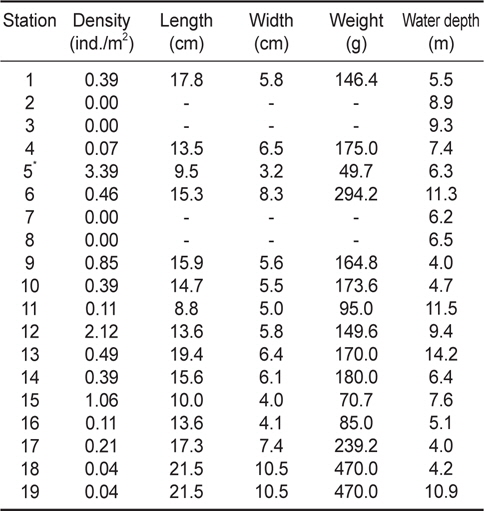
Appearance aspect of sea cucumber Stichopus japonicus at each station
태안군 해삼 양식어장의 퇴적물은 모래질실트(sandy silt)에서 자갈(gravel)에 이르기까지 다양한 유형을 보였다. 자갈과 모래, 실트, 점토의 함량은 각각 평균 17.4%, 42.1%, 28.5%, 12.0%로 모래가 가장 우세한 분포를 보였다(Table 2). 퇴적물의 평균입도는 -1.6-6.5 Ø 범위(평균 3.3 Ø)로 방포항과 천수만 입구에서 뚜렷하게 조립하였고, 신두리와 모항 남측, 안면도 서측, 천수만에서 뚜렷하게 세립한 경향을 보였다. 분급은 0.3-5.1Ø 범위(평균 2.7 Ø)로 매우 양호한 것에서 극단적으로 매우 불량한 것에 이르기까지 다양한 분포를 보였다(Table 2).
[Table 2.] The textural parameters and types of the surface sediment at each station
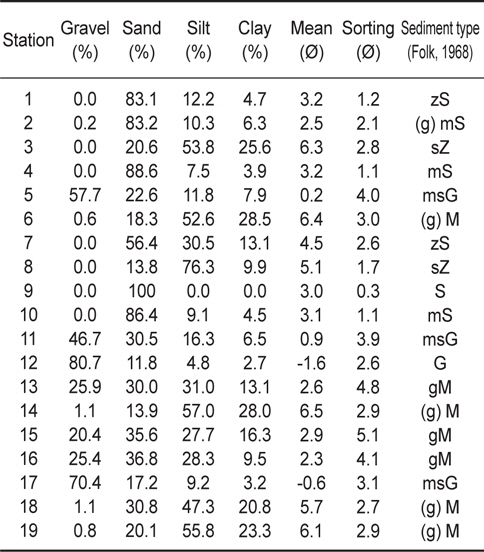
The textural parameters and types of the surface sediment at each station
퇴적물의 구간별 함량 분포를 살펴보면 19개 정점 중 9개 정점의 퇴적물이 복모드(bimode) 분포를 보이는 반면, 10개 정점의 퇴적물은 단모드(unimode) 분포를 보였다. 지역적으로는 모항 주변과 방포항 주변의 안면도 서측 및 남측 퇴적물은 복모드분포를 보인 반면, 그 밖의 지역의 퇴적물은 단모드 분포를 보였다(Fig. 2).
태안군 해삼 양식어장 퇴적물의 함수율(WC)은 15.6-42.1% 범위(평균 30.3%)로 다양한 분포 범위를 보였다(Table 3). 강 열감량(IL) 또한 1.4-7.1% 범위(평균 3.3%)로 다양한 분포 범위를 보였으며, 함수율의 함량비에 영향을 받기 때문에 함수율이 높은 곳에서 높은 유기물 함량비를 나타내었다. 화학적산소 요구량(COD)은 3.3-18.0 mgO2/g-dry 범위(평균 9.0 mgO2/gdry)로 이원방조제와 신두리 주변 해역에서 낮았고 모항 주변과 안면도 남서 해역에서 상대적으로 높았으나, 모든 조사 정점에서 일본의 수산환경 퇴적물 기준치인 20 mgO2/g-dry보다 낮은 농도 분포를 보였다(Table 3). 산휘발성황화물(AVS)의 농도는 0.007-0.369 mgS/g-dry 범위(평균 0.110 mgS/g-dry)로 대부분의 정점에서는 낮은 농도 분포를 보였으나, 모항 주변 등 일부 정점에서는 일본의 수산환경 퇴적물 기준치인 0.20 mgS/gdry보다 높은 농도 분포를 보였다(Table 3).
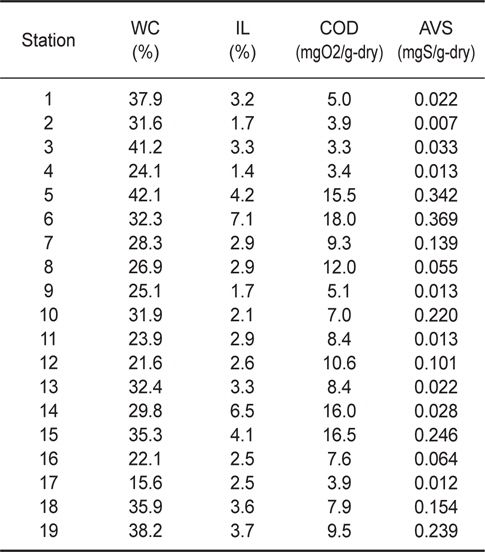
The concentrations of water content (WC), ignition loss (IL), chemical oxygen demand (COD), and acid volatile sulfide (AVS) at each station in the surface sediments
해삼(
태안군 해삼 양식어장에서 해삼의 출현밀도가 높은 지역과 낮은 지역의 표층퇴적물 입도분포 특성을 비교한 결과, 출현밀도가 높은 지역의 퇴적물은 주로 평균입도가 조립하고 분급이 불량한 반면, 출현밀도가 낮은 지역의 퇴적물은 상대적으로 평균 입도가 세립하고 분급이 양호한 경향을 보였다(Fig. 2). 또한 출현밀도가 높은 지역의 퇴적물 구성은 주로 조립구간의 함량이 뚜렷하게 높지만 조립구간과 세립구간에서 각각 최빈값을 갖는 복모드 분포를 보이는 반면, 출현밀도가 낮은 지역에서는 조립구간이나 세립구간에서 최빈값을 갖는 단모드 분포를 보여 퇴적물의 입도 및 분포 특성이 해삼의 출현밀도를 결정하는 중요한 요인임을 확인할 수 있었다(Fig. 2). 해삼의 체폭과 밀접한 상관관계를 갖는 체중은 퇴적물의 모드 특성와 무관하게 평균입도가 세립한 퇴적물에서 높게 나타난 반면, 평균입도가 조립한 퇴적물에서는 상대적으로 낮게 나타나 출현밀도 특성과는 다른 양상을 보였다(Fig. 2).
저질분석 결과 퇴적물의 함수율(WC)과 강열감량(IL) 값은 퇴적물의 평균입도가 세립한 정점에서 높고 조립한 정점에서 낮아 평균입도와 밀접한 상관관계를 보였다(Fig. 3). 화학적산소 요구량(COD)과 산휘발성황화물(AVS) 농도는 두 변수 간에 유사한 변화 패턴을 보이며 평균입도가 세립한 정점에서 높은 농도를 보였으나 함수율, 강열감량과는 다르게 평균입도와 밀접한 상관관계는 보이지 않았다(Fig. 3). 유기물 등의 오염물질을 산화제로 산화·분해시켜 정화하는데 소비되는 산소량을 나타내는 척도인 화학적산소요구량은 해삼의 출현밀도가 높은 지역에서 낮은 지역보다 높은 농도를 보이는 정(+)의 상관관계를 보였으나 모든 정점에서 일본의 유기물 오염기준인 20 mgO2/gdry를 초과하지 않아 건강한 서식지가 유지되고 있음을 확인할 수 있었다(Fig. 4). 퇴적물 내 산소의 고갈 및 결핍 정도를 나타내는 산휘발성황화물(AVS)의 농도 또한 해삼의 출현밀도가 높은 지역에서 낮은 지역보다 높은 농도를 보이는 정(+)의 상관관계를 보였으나, 화학적산소요구량의 농도 분포와는 달리 일부 정점에서 일본의 유기물 오염기준인 0.2 mgS/g-dry를 크게 초과하는 경향을 보였다(Fig. 4). 이에 반해 개인적으로 분석한 모든 시료에서 해삼 내장 속 퇴적물의 산휘발성황화물 농도는 불검출 된 반면, 화학적산소요구량의 농도는 서식지 표층퇴적물의 농도보다 두드러지게 높게 나타났다. 일반적으로 해삼은 표면 하수 mm 이내에서 구강 촉수(buccal tentacles)를 이용하여 먹이를 섭취하는 퇴적물 식자로 알려져 있다(Massin, 1982). 이들의 생태계에서 주요 역할은 생교란 작용을 통해 통기효과를 증대시키고 용존된 유기물질을 수계 내로 공급하여 저서환경을 개선시키는 것으로 알려져 있다(Massin, 1982; Uthicke, 1999; Yamada et al., 2009; Bellchambers et al., 2011). 이러한 현상을 고려할 때 해삼 출현밀도가 높은 지역에서 산휘발성황화물의 농도가 뚜렷하게 높게 나타나는 현상이 산휘발성황화물의 농도가 높은 지역을 해삼이 서식지로 선호하기 때문인지 또는 해삼에 의한 다량의 배설물 등에 의해 농도가 높아 진 것인지, 그렇지 않으면 두 경우와 무관하게 지역적인 특성에 의한 것인지에 대해서는 명확한 판단을 내릴 수 없으며, 이에 대해서는 추후 보다 면밀한 조사가 이루어져야 할 것으로 판단된다.
